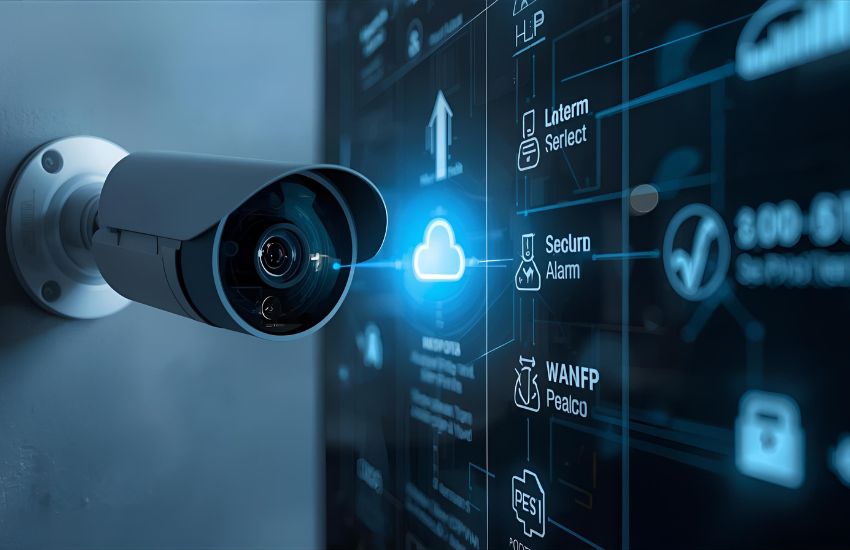A single camera can do more than just capture images—it can actively protect your property. When an IP camera is paired with alarm input and output capabilities, it transforms from a passive observer into a responsive security device. This fusion of real-time monitoring and physical response opens new possibilities in modern surveillance.
Maximize security efficiency by integrating smart IP camera alarm outputs with your existing system. This seamless connection enables instant alerts and automated responses, enhancing real-time monitoring and threat detection. By combining advanced camera technology with alarm integration, you ensure faster reactions, improved accuracy, and comprehensive protection for your property and assets.
In this blog, you’ll discover how IP cameras with alarm input and output enhance your overall security strategy. We’ll explain how to properly wire and connect your camera to various output devices, when and why to use different input types, and how to set up your system to respond precisely when needed.
Configure Alarm Input and Output Easily on Any IP Camera Device

Understanding Alarm Input and Output
To enhance your surveillance system’s functionality, it’s essential to configure alarm input and output on your IP camera device. Alarm input allows the camera to receive signals from external devices like motion sensors or door contacts. On the other hand, alarm output lets your camera respond to events by triggering an external alarm, such as a siren, strobe light, or relay button.
Integration Made Simple
Modern systems make it easy to integrate third-party equipment like PIR sensors or emergency switches. Once properly configured, these sensors can send signals to your IP camera to initiate actions like recording or sending a push notification. Similarly, output connections can activate an external alarm in real time. Whether you’re using a Dahua, Hikvision, or any other compatible system, most interfaces are user-friendly and adaptable.
Activating and Managing Alarm Events
With proper settings, your IP camera alarm system can respond instantly to suspicious activity. You can set parameters to trigger alarm events when motion is detected or when a door is opened. The alarm event can then prompt automatic recording or communication with a control center.
This section has guided you through the basics of alarm input/output integration. In the next section, you’ll learn how to connect these features with external devices, and explore best practices for optimizing your alarm setup across platforms like IP Cam Talk or through your device manufacturer’s Help Center.
See more about...Wireless Outdoor Security Camera System
Connect Camera Alarm Output with External Wire Using Web Interface

To strengthen your surveillance response system, it’s essential to understand how to connect camera alarm output with an external wire using a web interface. This process allows you to extend your IP camera’s functionality beyond video monitoring, empowering it to activate physical devices like buzzers, lights, or sirens during security breaches.
Using the camera’s web interface, you can configure the output settings to integrate various motion sensors, including PIR units, or physical triggers such as panic buttons. Once connected, the system can detect movement or intrusion and immediately activate an action, such as sounding an alarm or flashing a strobe. These outputs are often wired through a relay or pigtail, forming part of a closed or open circuit depending on whether your camera’s alarm terminals are normally open or closed.
You may also choose to integrate your setup with smart sensors or automated buttons, adding an extra layer of interaction and responsiveness. Whether the motion sensors detect movement or a panic button is pressed, these triggers ensure fast action is taken to prevent unauthorized access. By linking outputs to devices via a simple browser-based web interface, you take full control of your alarm functionality—effectively transforming passive monitoring into proactive security.
See more about…IP Cameras with Long Range Wireless Bridge
Conclusion
Take a deep breath and consider the possibilities when you integrate advanced motion sensors, PIR units, and security buttons into your IP camera system. By using the web interface, you can seamlessly configure every event to automatically activate a physical action, enhancing your system’s ability to respond to real-time threats like unauthorized access or intrusion.
When an event occurs—whether triggered by PIR detection or a pressed button—your camera can respond instantly by activating an output such as a buzzer or flashing light. This not only improves reaction time but adds a physical deterrent to your surveillance network. The use of a pigtail and simple circuit connections allows you to wire in additional components, while the web interface helps you manage, test, and activate them with precision.
Integrating multiple motion sensors and smart buttons empowers your system to respond effectively to every security event. Whether you’re automating an emergency action, reinforcing perimeter protection, or building a robust alarm circuit, your ability to control and activate components through a browser-based web interface makes modern security both intelligent and efficient.
See more about…IP Camera Streaming
Frequently Asked Questions (Maximize Security Efficiency with Smart IP camera alarm output Integration)
What is alarm output in a CCTV camera?
Alarm output in a CCTV camera is a feature that triggers external devices, such as sirens, lights, or alarms, when the camera detects motion or an event. It acts as a signal port that activates connected security equipment, enhancing real-time response and deterrence. This integration improves overall security by providing instant alerts and actions.
How to integrate a CCTV camera?
To integrate a CCTV camera, first choose the right type (IP or analog). Connect analog cameras to a DVR or IP cameras to an NVR via network cables or Wi-Fi. Ensure proper power supply, configure camera settings, and connect to a monitor or app. Test the system for clear video and remote access functionality.
What is IP in security cameras?
In security cameras, IP stands for Internet Protocol, which allows cameras to transmit video and audio data over a network or the internet. IP cameras provide higher resolution, remote access, flexible installation, and advanced features like motion detection and cloud storage. Unlike analog cameras, they connect via Ethernet or Wi-Fi, making surveillance smarter and more scalable.
How to increase security camera quality?
To increase security camera quality, use a higher resolution camera (1080p or 4K), ensure proper lighting, and clean the camera lens regularly. Adjust camera settings like brightness, contrast, and focus for clarity. Use quality cables or a stable Wi-Fi connection, and consider upgrading DVR/NVR systems to support better resolution and compression standards like H.265.
